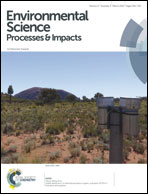Chemical fingerprinting of hydrocarbon-contamination in soil†
Abstract
Chemical fingerprinting analyses of 29 hydrocarbon-contaminated soils were performed to assess the soil quality and determine the main contaminant sources. The results were compared to an assessment based on concentrations of the 16 priority polycyclic aromatic hydrocarbons pointed out by the U.S. Environmental Protection Agency (EPAPAH16) and total petroleum hydrocarbon (TPH). The chemical fingerprinting strategy proposed in this study included four tiers: (i) qualitative analysis of GC-FID chromatograms, (ii) comparison of the chemical composition of both un-substituted and alkyl-substituted polycyclic aromatic compounds (PACs), (iii) diagnostic ratios of selected PACs, and (iv) multivariate data analysis of sum-normalized PAC concentrations. The assessment criteria included quantitative analysis of 19 PACs and C1–C4 alkyl-substituted homologues of naphthalene, fluorene, dibenzothiophene, phenanthrene, pyrene, and chrysene; and 13 oxygenated polycyclic aromatic compounds (O-PACs). The chemical composition of un-substituted and alkyl-substituted PACs and visual interpretation of GC-FID chromatograms were in combination successful in differentiating pyrogenic and petrogenic hydrocarbon sources and in assessing weathering trends of hydrocarbon contamination in the soils. Multivariate data analysis of sum-normalized concentrations could as a stand-alone tool distinguish between hydrocarbon sources of petrogenic and pyrogenic origin, differentiate within petrogenic sources, and detect weathering trends. Diagnostic ratios of PACs were not successful for source identification of the heavily weathered hydrocarbon sources in the soils. The fingerprinting of contaminated soils revealed an underestimation of PACs in petrogenic contaminated soils when the assessment was based solely on EPAPAH16. As alkyl-substituted PACs are dominant in petrogenic sources, the evaluation of the total load of PACs based on EPAPAH16 was not representative. Likewise, the O-PACs are not represented in soil quality assessments based on EPAPAH16 and TPH. The ∑O-PACs ranged between <limit of detection (LOD) (0.03 mg kg−1 (dw)) and 150.61 mg kg−1 (dw). The pyrogenic contaminated soils contained considerable amount of O-PACs corresponding to between 6 and 18% of the ∑EPAPAH16.


 Please wait while we load your content...
Please wait while we load your content...